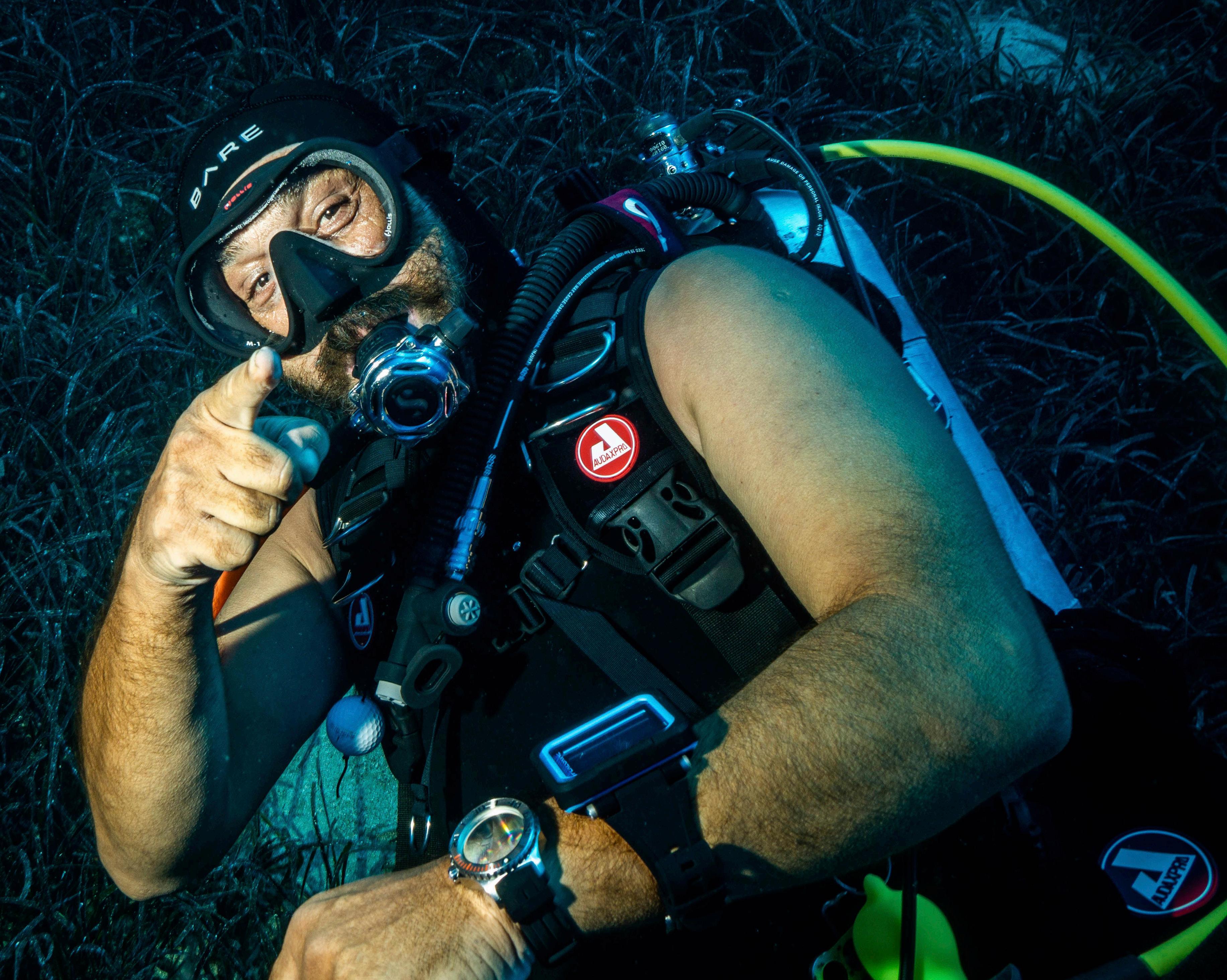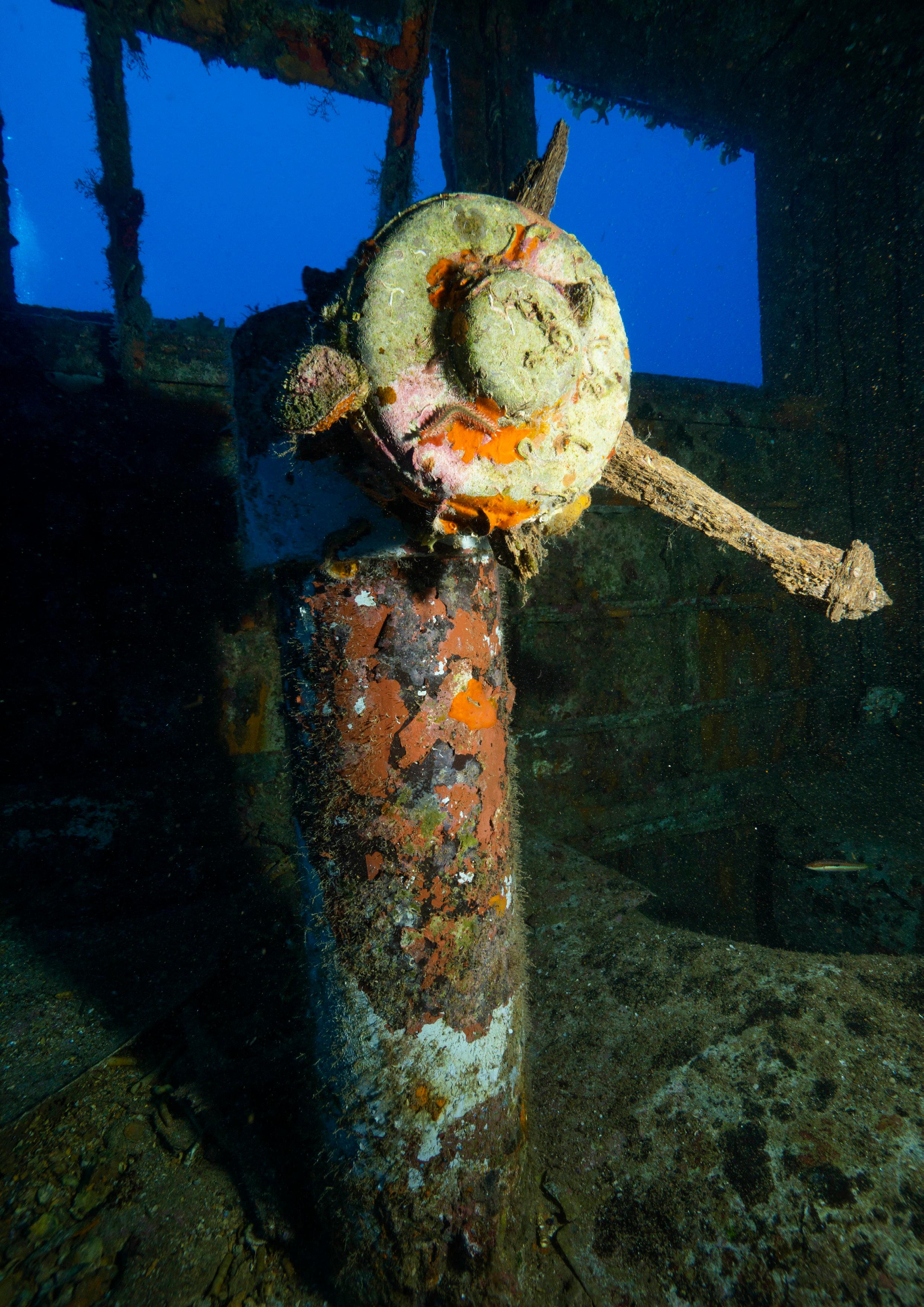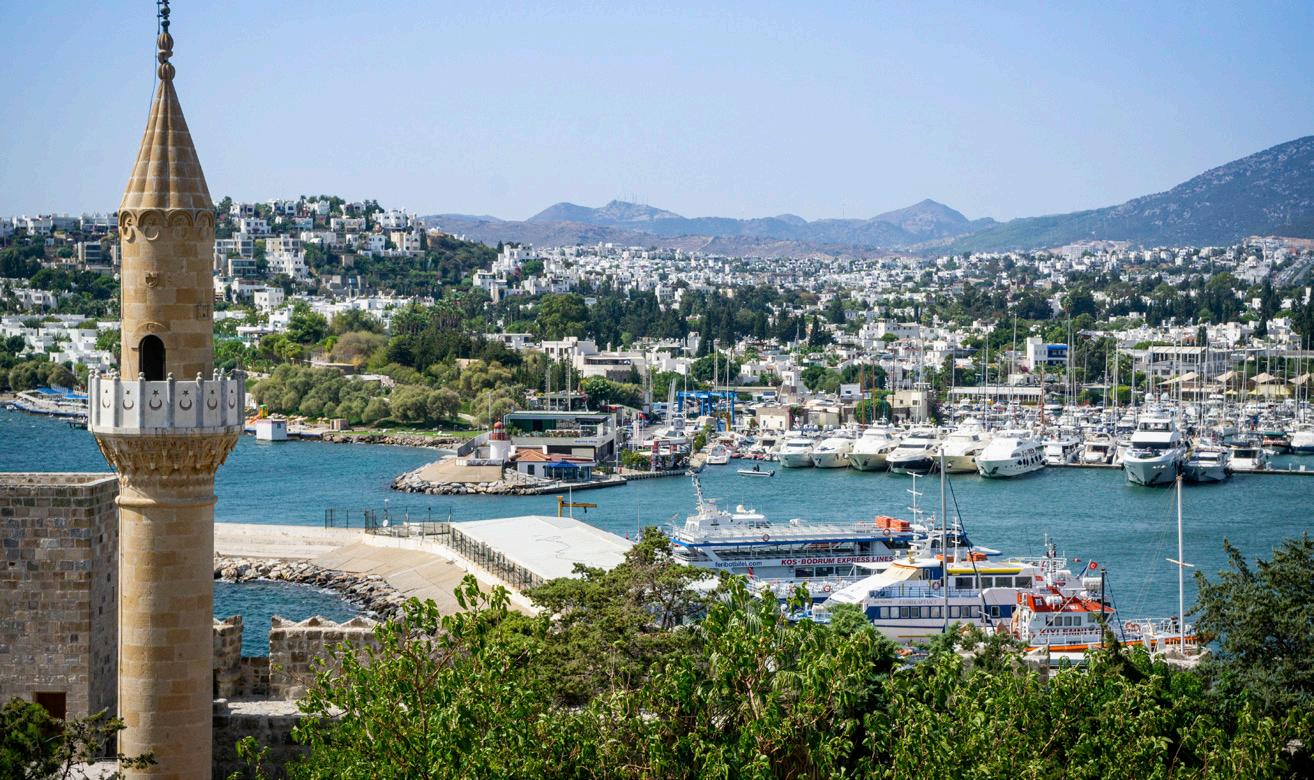
14 minute read
Turkish Surprise – Scuba Diving During the Global Pandemic
FEATURE AND PHOTOGRAPHY FARHAT JAH

The shallows of every bay are packed with fish.
Only a few hours away by flight from the UAE, lies the Anatolian plateau and its enormous coastline. The corona pandemic has destroyed dive tourism as we know it, and there are so few places that UAE residents can go to dive. On a whim, Raf Jah decided to explore one small corner of his native country and he came back with rave reports. The diving season in Bodrum in Turkey is closed for now, but re-opens early next year. This is what he found.
I won’t lie, I am Turkish. I could live anywhere around the world, but my Turkishness will never desert me. I also have high expectations. I did my Divemaster training in Turkey but was not impressed with the marine life. But now COVID-19 had intervened in my life, and I was desperate to dive. So with rather low expectations, my wife Francisca and I flew to Istanbul, hired a car and drove across Turkey to Bodrum (we could have flown, but we planned to explore more of Turkey later on).
KENAN DOGAN, BODRUM’S DIVING PIONEER

Kenan Dogan, one of Bodrum’s diving pioneers.
The one problem we had was choosing who to dive with. There are plenty of operators in Turkey but we were completely out of touch. I had made a contact from a dive trade show I attended a few years back, to a man named Kenan Dogan. I rang the number on the website.
“Can we dive with you?” I asked. “I am a dive tour operator, but I hear you are pretty full”.
“Come, come”, he shouted down the phone; “I’ll give you a discount, but just come to Bitez Port, 09:30 tomorrow”. And with that, the phone clicked and he was gone.
Kenan was a gruff character, but he was squeezing us onto his dive boat during a global pandemic, so who was I to complain!

Fish on the MV Pinar 1.
The next morning, we turned up early and looked for the AquaPro dive vessel. We found it moored at a jetty and loaded our kit onto the boat. Unlike most of the Turkish dive boats, this was not a wooden taka (Caique) with a marinised Ford truck engine. Rather, it was a purpose-built metal hulled dive platform with twin Volvo Penta diesel engines. The ‘MV Vertigo’ reminded me very much of a slightly small Red Sea liveaboard. The dive deck was run by a steely blue-eyed man by the name of Can (pronounced Jaan in Turkish). A veteran security officer, he was also a CMAS instructor and a good organiser. He conducted a few basic checks, our temperature was taken, and we then went upstairs to sit down. Soon enough, a tall, wizened man with a thick black beard and sunglasses appeared.
“Ferhat!” he shouted at me. Kenan Dogan had arrived. He walked straight up to the helm, turned on the engines and watched them warm up. As soon as he was satisfied with his gauges, he tooted the horn three times as a signal to his crew and any late comers, and we slowly chugged out of Bitez Port.

One of the caves.
Like every adult Turkish man, Kenan had been conscripted into the Turkish Armed forces at the age of 19. He had been selected for dive training and had spent his two years as a Turkish naval diver. As soon as he was discharged from the Navy, he became a commercial diver and then went on to open his own dive centre. At the age of 56, he has been diving in the Bodrum area for the last 30 years and as he was to prove, there was very little he didn’t know. Since 2007 Kenan and his friends had been instrumental in sinking three wrecks in the area.
PINNACLES AND REEFS IN THE AEGEAN
45 minutes after leaving the Bitez Port Marina, Can came upstairs and told us it was time to dive. We pulled on our scuba gear and lunged into the water. I descended on what looked like a pile of rocks. This, I thought gloomily, was going to set the tone for the rest of the day. But upon looking carefully, I realised that we had actually landed on an underwater pinnacle. Can was getting the group together and so I looked down and around. This pinnacle was massive, it rose off the floor of the Aegean Sea.

The Aegean is full of colourful sponges.
Can signalled that all was well and that we should head off and descend. We were diving in two buddy teams. Can took us slowly along the reef descending gently from one cluster of rocks to another. At each cluster there was a burst of life. My Inon strobe lit up the sponges under every rock. We swam slowly deeper and deeper, and then Can broke off to play with a school of barracuda, swimming lazily underneath them. They were not as large as the barracuda that you find off Papua New Guinea, but they were definitely barracuda and they were bunched up into a circling mass.
We bottomed out at around 32 metres. We were now well off the wall on the sandy bottom. Can was poking around some enormous boulders. He called me over. He had found nudibranchs, gobies and anthias. My flash unit fired and lit up the multitude of sponges and small fish. It never occurred to me that the Mediterranean could be so colourful. In my youth I had heard about the Turkish Sponge Divers who had discovered ancient shipwreck after ancient shipwreck, but I didn’t think there were any sponges left.
My computer started to beep. I had been down a while. I checked my SPG which read way too much air. I banged it and the gauge dropped a few bar.
“I must remember to grease that spigot O ring” – I made a mental note.
My computer would not let up, and not wishing to turn my first dive into a deco dive, I thought I should perhaps wend my way slowly upwards. We regained the wall, and then swam along it at around 18 m, meeting the other divers from the boat. They had stayed at 18 m but they clearly looked very happy. At this depth, schools of bream were swirling around us and even more smaller fish darted in and out of the rock face. By the time I reached 50 bar, we had circumnavigated the reef. I did my now mandatory safety stop and then climbed back aboard. If this dive was representative of what was to come, Turkish diving definitely had something worth visiting.

The remains of an amphora in a cave at 32 m.
Kenan pulled out a backgammon board and flagged down a passing boat. The pleasure craft was skippered by his friend who responded by turning into the bay, mooring up, and coming aboard. Three rather fast and very furious games of backgammon ensued.
When the discover scuba divers had finished, the snorkellers had tired, and we had finished our sandwiches, it was time for our second dive. Barracuda Bay was a steep wall that ended at 33 m with a series of caves. Can and his buddy wandered off while I took photos. The grooves cut into the volcanic rock made for some dramatic scenery, and the usual fish suspects were out and about. At the end of the dive we were so taken by what we had seen, that we wanted to do more.
“Can we dive a second day?” I asked Kenan. Kenan could see that we were seriously interested.
“You like it here!”
“Well it is certainly interesting.” I was being non-committal.
“Tomorrow we will dive the ‘Pinar 1’. My friends and I sank it,” Kenan said enigmatically. And with that we disembarked.

Divers at the Dakota DC3 aircraft.
TURKISH NAVAL TENDER: PINAR 1
The Pinar 1 was laid down in Germany in 1938. She was then sold to the Turkish Naval Forces Command and entered service as a fleet tender. She would supply water to the destroyers and frigates. As the world’s navies modernised, Turkey’s fleet stayed the same. Her older warships did not have the ability to desalinate and therefore a fleet water tender was as essential as an ammunition carrier. It was only in 2007 that the need for a Pinar 1 diminished. The Turkish Navy agreed to donate her to the Turkish Scuba diving community. She was stripped of military material, recyclable materials, cleaned and handed over to the Bodrum Underwater Association. The Turkish Naval Forces Command towed her free of charge to Bodrum. There the Turkish Divers set about making her safe for diving and conducted a final very deep clean.
In 2007 she was sunk in a spot agreed by the Divers Association, the Turkish Coast Guard and the local government. The Bodrum Divers sited the vessel and pumped her full of water. As she started to sink, Kenan Dogan was the last man off her decks as he boarded a waiting dingy. All of which can now be seen on YouTube! This was to be our wreck of the day.
Can took us down a slope of rocks, until a shape emerged out of the gloom. This was the stern superstructure of the Pinar 1. The vessel was lying bow down but upright on the sand. I circled the stern at 15 m taking a few photos, staying well off the bottom. Can signalled us to follow. I stayed at 15 m trying to take in the whole wreck in the 30 m visibility. There was sea grass and sand all around her. I looked down and a moray swam freely between the long blades of grass. Schools of fish descended down off the deck and went towards the sand.
Can signalled wildly and I looked into the blue. Some rather large stingrays rose off the bottom and swirled out in front of the bow. I could not take a photo as they were beyond the reach of my lens. A moray swam freely through the grass below the freighter. By now we were at the bow and I could take it no longer. I dropped to the floor in front of the bow. I hovered above the sand at 36 m and shot the Pinar 1’s bow with Francisca swimming beside her. We closed in on the bow and saw rabbit fish hanging around where the bow met the sand at 32 m. The view of the side of the freighter and the sun shining down on us through 30 m of blue water was serene. I snapped off a few more shots of the hull, for ships, rivets and holes interest me. They are always covered with life.

The wheelhouse of the Pinar 1 wreck.
The Pinar 1 was a magnet for fish. As with most of my Turkish dives, my computer started to complain. While AquaPro Dive Centre welcomes tech divers and rebreather divers, there was a standing request for no decompression stop diving unless prearranged. With one minute remaining, I ascended to the deck and mast. Here my Aladin relented and I levelled off to explore the superstructure and rail lines. Lionfish had arrived in the Aegean and I found them around the hatches. While they may be destructive, they make great photographic subjects. Cisca pointed out loads of nudibranchs on the railing, and after a deck swim through, it was time for our safety stop and eventual ascent.
“I am blown away by the marine life,” I said to Joby Dogan, Kenan’s wife and the organiser of all activities on the MV Vertigo.
“There are 8 different types of nudibranchs that we see on a regular basis here, this is an excellent area for macro photography”, she confirmed.
“It’s pretty good for wide angle as well!” I retorted, thinking of the Pinar 1.
“Oh we have a lot more wrecks, do you want to see the plane next?” she asked. “It really is down to choice. We have 30 dive sites which are great, but not everyone wants to wreck dive.”
We did more in the area, on reefs, with many schools of groupers and rock faces, and we dived a dramatic broken up Dakota DC3 aircraft (another military gift). Can guided all but one of our dives, forgiving me of my trespasses. In all our days, we did not manage to dive Barracuda Point, the Coast Guard Cutter wreck or half of Kenan’s walls. But on our last dive, Kenan strapped on his twin set, forward rolled into the water and took us down a reef. It was packed with groupers hunting smaller fish, colourful sponges, octopus and stunning underwater scenery. The visibility was around 50 metres and it was a wonderful end to our day. My buddy and I squeezed an hour out of my tank and we ascended to our usual spot on the flying bridge next to Kenan.
“Your mind is like mine,” he said. “It’s full of projects”.
“Well Turkey is my project now,” I replied.
“I have another project,” he said quietly. “A new wreck, a big one maybe,” and he winked at me. “You will have to come back”.
TURKEY: KNOW AND GO
GETTING TO BODRUM
Getting to Turkey from the UAE has never been easier. Turkish Airlines and Pegasus connect the UAE to Bodrum via Istanbul and Turkish Airlines offer “visit Turkey” fares. www.thy.com

A view of Bodrum Harbour.
We flew to Istanbul on Turkish Airlines and hired a car from Avis. The reasons for this was that there was simply so much to see in Turkey. www.avis.com
DIVING IN BODRUM-AQUAPRO BITEZ
Every coastal town in Turkey has a series of dive centres. All dive operations in Turkey are regulated by the Turkish government’s eminently sensible but strict maritime and diving laws. As you may have read in the article, we dived with Kenan and Joby Dogan at Aquapro Bitez. Joby is an SSI, NAUI, CMAS and PADI instructor, and Kenan has more qualifications than I can remember, including vessel captain, and commercial hard hat diver.
Divers are split into groups depending upon their ability, with advanced divers being given smaller groups. All dives are led by a registered dive leader, but photographers are catered for. The best times to dive are in the spring: April, May, June and after the summer rush – so September and October. The diving is excellent in July and August, but this is peak season and prices in hotels are always higher at this time of year.
AquaPro also offer Technical Diving, and full rebreather support. www.aquapro-turkey.com
STAYING IN BODRUM
Bodrum has every level of accommodation from tiny guest houses to the most luxurious hotels. We stayed at the Marina’da Hotel which is opposite the Bitez Marina. It has an excellent authentic Central Asian restaurant and bar, and overlooks the sea and Bitez Bay. Moreover, it is a 30 seconds walk from the dive boat. Opposite is a superb restaurant called Bitez Café. For those wanting more luxury, the Ramada by Wyndham is a few minutes walk up the hill. Beyond this there are self catering apartments in Bitez and many, many more hotels. www.otelmarinada.com
BODRUM CASTLE
No visit to Bodrum is complete for a scuba diver without a visit to Bodrum’s Crusader Castle. Here you will find the archaeology museum with George Bass’ discoveries, the famous underwater archaeologist. Almost every underwater find is brought to this small, but excellent museum for display.
TURKEY – NOT JUST ABOUT THE DIVING
Civilisation in Turkey is thousands of years old. There are tombs that date back to the Trojan Wars just above Bodrum. Two and a half hours away are the ancient ruins of Ephesus. Further afield, the ancient cities of Hatusa (near Corum) https://bit.ly/2ITCy7Y and Catalhoyuk (near Konya) https://bit. ly/2IQwkpx completely rewrite our understood history of mankind.
Of a slightly more recent ear are the Selcuk mosques, palaces and citadels. Then the Byzantines built in ancient Constantinople, including the city walls and the Aya Sophia Church. Constantinople became Istanbul in 1453 with the advent of Sultan Mehmet the Conqueror, at which time the Byzantine Empire entered its decline. Anatolia and Istanbul flourished under the Ottomans, and their architect Sinan produced some of the most magnificent architectural treasures to date. In 1923, the architecture of Turkey changed with the creation of the Turkish Republic, and a new 1930s art deco style was introduced, with a clear Teutonic influence. Since the 1990s Turkey has boomed economically, and most cities now have modern glass and concrete centres with shopping malls and wide boulevards. All of this means that hiring a car or taking trains and buses around Turkey is a fundamentally worthwhile cultural, culinary and historic experience.
FOR PACKAGES FROM THE UAE, YOU MAY CHOOSE TO USE:
www.orientafricatravel.com










